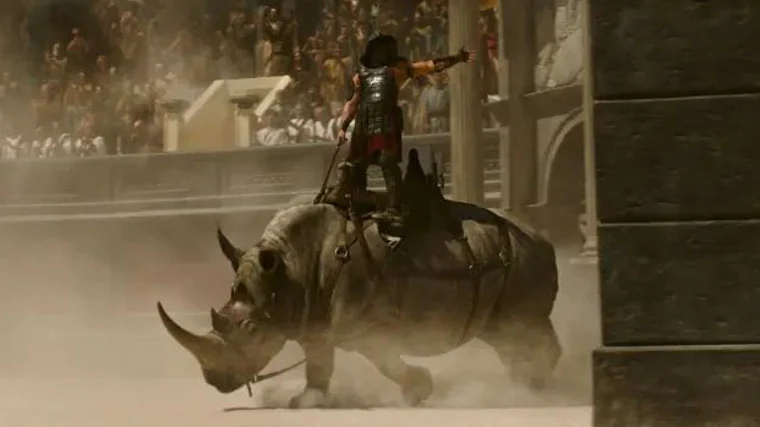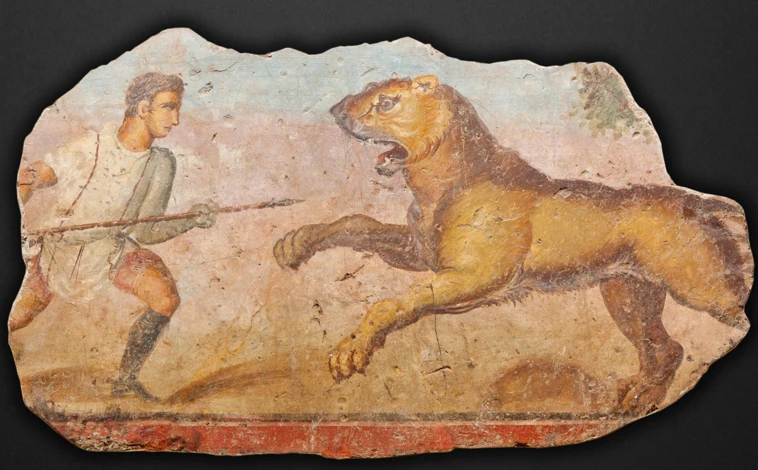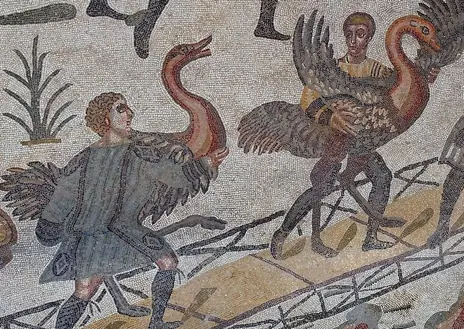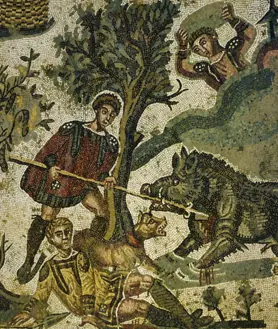Let the wild beasts roar and fight bravely for the crown of the steppe, and let them do so for the joy of young and old in the center of the civilized world. «A bull stimulated with fire went throughout the arena throwing the bulls up to the stars. “He finally succumbed, not being able to resist another, more powerful horn, because he believed it was so easy to get rid of an elephant.” Marco Valerius Marcial, chronicler and poet of the Eternal City, recorded in his epigrams the most spectacular battles between beasts that were organized to celebrate the inauguration of the Colosseum in Rome in 80 AD. C. And he did the same with the hunts – ‘venationes’ – that pitted men and exotic beasts against each other in those rings that are today current thanks to ‘Gladiator II’.
Goats and rabbits, of course, but add ostriches, leopards, tigers, panthers, hippos and even a damned polar bear to the list. For centuries, the most unknown animals from the East and West arrived at the amphitheaters of the Republic and the Empire, and they did so after being captured and transported by land and sea from regions located thousands of kilometers from Rome. «Exorbitant prices were paid for them and large expeditions were organized in which there were even veterinarians. “What was moving around it was impressive: a gigantic economic, political and social infrastructure,” the historian and doctor in Classical Archeology explains to ABC. María Engracia Muñoz-Santosauthor of the thesis ‘Animals, beasts and beasts in Roman spectacles’ and co-author of ‘Gladiators, courage in the face of death’ (Desperta Ferro).
Alfonso Mañas is of the same opinion. The doctor in Sports History with the thesis on gladiature and author of the recent ‘Gladiators, beasts and the damned. The brutal chronicles of the Colosseum‘ (Almuzara) acknowledges to ABC that the beasts played a central role in the Eternal City games. And, incidentally, he remembers an example that earned the devotion of dignitaries and citizens: «The chronicles tell us about a white rhinoceros – this type was used because the black one had a worse character – that gave great shows. It must have captivated society, because it appears on a coin minted by Domitian in the year 85 AD. C., a ‘quadrans’.
Today, one and another they reveal to us how on earth these beasts reached the heart of the civilized world.
On the hunt
The expert says that the data is scarce, but that the process is clear. The trip usually began with a specific order for some games. “The Emperor could do it, or a private politician who wanted to organize a show with animals,” he explains. The best surviving example is six letters from 51 BC in which Marcus Caelius Rufus asked Cicero to pull his strings with one objective: to obtain a shipment of pantherae from the East with which to celebrate his future victory in the elections. to curul councilor: “I ask you that, as soon as you have news that I have been elected, you take care of matters relating to the panthers.” During the Gallic War, Caesar did the same with Pompey, although he asked for lynxes. A matter of taste.
With the order on the table, the buyer chose the region from which the animals would be obtained. The more hidden it was, the more the price and society’s expectations increased. Muñoz-Santos takes the floor, and does so to draw a mental map of the expansion of the Eternal City. With him we traveled to Hyrcania – in Central Asia –, Libya, Tunisia… Animals were imported from all of them, and many of them were preceded by fame. «Hispanic horses and lynxes were very recognized; The Romans adored them. And the same thing happened with the bears of North Africa,” he says. Greek lions were also famous, but “the massive hunt ordered by the Romans” to fuel the spectacles ended up making them extinct.
Detail of the Mosaic of the Great Hunt, located in the Roman villa of Casale de Piazza Armerina in Sicily (Italy)
Already on the ground the capture, not the hunt, began; because the second implied the death of the animal, and the Romans sought to ensure that the beasts reached the amphitheaters healthy, safe and unbruised. Mosaics from the period such as the one preserved in Piazza Armerina (Sicily) show that the legionnaires themselves were in charge of this task. Muñoz-Santos, however, is in favor of the fact that they delegated it to the natives in exchange for some trinkets. «We have evidence that there were soldiers who captured bears in Germany, it was their only job. But the reality is that, in many cases, they did not represent the real captors in the paintings because they wanted to show themselves as great heroes to their people,” he notes.
The thousand methods for hunting wild animals have been recorded in engravings, mosaics and sources. Opiano, the poet of the second century AD. C., explained with many hairs and many other signs the cruel trick to capture “a roaring lion with abundant mane.” In his words, one had to “dig a large, wide, round hole,” drive a long vertical pole into it, and finally tie a suckling lamb into it. “Thus, the animal cannot see the deceptive hole and falls into it,” he added. It was not strange that an open cage was also placed at the bottom, which, once the ruse was completed, was closed and raised. The system was similar, although with caveats, for elephants and bears.

Still from Gladiator II
We asked Muñoz-Santos about any other technique that has stuck in his mind, and he doesn’t hesitate for a second: “The one with the lion cubs was the cruelest!” He is right, because the process began with a kidnapping. «The captor, mounted on horseback, took the cubs from the den and took them away. When his mother noticed, she would run after him,” he explains. If the rider was in danger of being hit by the animal, he would throw one of his prey to the ground. “The lioness had no choice but to stop, let him flee, and return her offspring home with her mouth,” he concludes. Sad, but as effective as dropping a glass of wine into a bucket of water so that, if the beast stopped to drink, it would be stunned.
Towards Rome
Once the prey was captured, the long – very long – road to Rome began. The first trip was to the pier, and was done on foot. The smaller animals were tied to a pole and carried on their backs; Larger ones, such as elephants, had their legs tied to prevent them from escaping. The real challenge was getting them on the boat. The pachyderms, for example, were so skittish that they had to ascend the catwalk backwards so they wouldn’t know what was happening. And the Jordanian ostriches, smaller than the current ones, were carried by hand, under the arm, like a bundle. This has been represented in mosaics such as the one in Piazza Armerina.
Then began a journey that, according to Mañas reveals, was quite fast: «White rhinos, for example, were captured in the Ethiopian area. From there they went up the Nile by boat and reached Alexandria. Then they were transferred to the Roman port of Ostia. Now less than 35 kilometers from the Eternal City, on the coast of the Tyrrhenian Sea, the only thing left to do was to embark them again towards their final destination. “In the case at hand, he went up the Tiber River to the city of Rome itself,” completes the author of ‘Gladiators, beasts and the damned’. And for example, an engraving on a sarcophagus at the Villa Medici that represents the transport of two caged lions on a merchant ship.



Mosaic from Mérida depicting a hunt (above). Below left, transportation of ostriches in the Great Hunt mosaic. Next to it, another extract from the same mosaic.
The trip, according to Muñoz-Santos, was not as long as it might seem: «Pliny the Elder tells us that the journey from Alexandria to Ostia could be done, with pleasant temperatures and good seas, in three days. If we add the time it took to transport them from Africa, it would be weeks or months. What it was, and a lot, is exhausting, since each animal required specific care. “Hippos, for example, needed fresh water to stay hydrated and not suffer sunburn,” he adds. At the same time, he adds a fact that is often overlooked: one of these animals ingests 68 kilograms of grass a day. And that, not to mention the problems of maintaining hygiene on ships. “Do you know how much excrement an elephant produces per day?” he jokes.
If they passed all these tests and arrived at their destination alive, our exotic protagonists went on to reside in the ‘vivaria’: menageries where they waited their turn to attend the shows. The Roman official of the 2nd century BC. C. Marcus Terence Varro explained in his writings that he visited one in the region of Laurentum: “It was a forest of more than fifty acres with a stone fence.” The co-author of ‘Gladiators, courage in the face of death’ states that the beasts “lived freely in them, without cages”, and that those responsible “avoided mixing species” that could confront each other. “We know that one was created just for elephants!” he adds.
The last route was the one that took the beasts from the ‘vivaria’ to the hypogeums of the amphitheatres. In the case of the Coliseum, it was normal for it to be done the night before the show. That the streets were less crowded reduced the problems, but did not prevent them. Pliny the Elder wrote that a panther escaped from its cage and killed a famous artist named Praxiteles. On paper, this Homeric journey ended here. The reality, however, is that many beasts were forgiven for their heroic performance in the arena and were returned to the breeding grounds. «The clearest example was the aforementioned white rhinoceros. That Marcial dedicated five epigrams to him in his texts reveals his importance. He was brought for the inauguration of the Colosseum, in the time of Titus, and was still alive in the time of Emperor Domitian,” concludes Mañas.
#Rhinos #polar #bears #long #journey #extravagant #beasts #Colosseum #Rome
